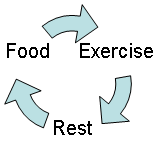Introduction, because the fight/flight response is preparing the body for physical action, there are many who argue that the best stress relief activity is physical exercise. It is a natural way to act on the body’s preparation for movement and use up the energy and the stress chemicals in a safe and socially appropriate way. In particular, exercise is the best way for us to address the glucocorticoids and burn them out of our body.
Neuromuscular stress responses that tighten skeletal muscles can be addressed with strategies that send messages via nerves to switch off tension (e.g.. tell your shoulders to drop down right now, practice body scanning, muscle relaxation techniques, movement arts, yoga, Tai Chi, muscle tension biofeedback, increase awareness of body alignment/posture, decrease overuse of muscles during everyday activities, etc., etc.).
Hormone stress responses may be addressed by exercise and deep relaxation. 20 – 25 minutes of deep physical relaxation help rid the body of the effects of the glucocorticoid and thyroid hormones. Daily deep relaxation practice strengthens immune function. Many meditator's have been found to relax their mind but may not be getting significant body relaxation from their meditation practice. It is possible use biofeedback monitors to check the depth of physical relaxation achieved with various relaxation and meditation techniques.
Physical Awareness:
Awareness of the physical symptoms of unhealthy stress in our body's allows us to give care to them sooner. Unfortunately if we are un-aware or ignore what is happening in our bodies the stress becomes unhealthy.
Physical Caring:
When we care about our body, the rewards are wonderful. The condition of the body directly affects our emotions and thoughts. It has been when the body is happy so is the mind. We care for it with a balanced amount of food, exercise and rest.
